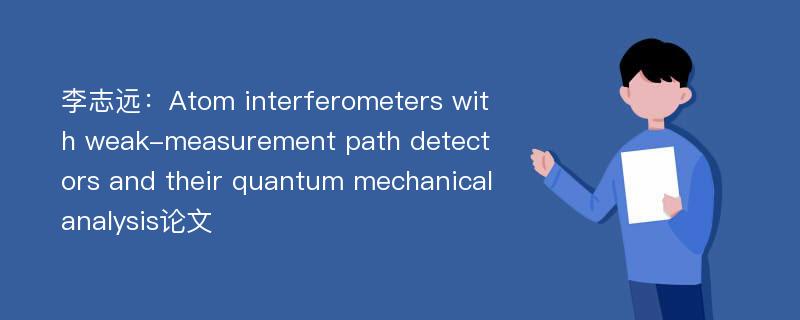
本文主要研究内容
作者李志远(2019)在《Atom interferometers with weak-measurement path detectors and their quantum mechanical analysis》一文中研究指出:According to the orthodox interpretation of quantum physics, wave-particle duality(WPD) is the intrinsic property of all massive microscopic particles. All gedanken or realistic experiments based on atom interferometers(AI) have so far upheld the principle of WPD, either by the mechanism of the Heisenberg’s position-momentum uncertainty relation or by quantum entanglement. In this paper, we propose and make a systematic quantum mechanical analysis of several schemes of weak-measurement atom interferometer(WM-AI) and compare them with the historical schemes of strongmeasurement atom interferometer(SM-AI), such as Einstein’s recoiling slit and Feynman’s light microscope. As the critical part of these WM-AI setups, a weak-measurement path detector(WM-PD) deliberately interacting with the atomic internal electronic quantum states is designed and used to probe the which-path information of the atom, while only inducing negligible perturbation of the atomic center-of-mass motion. Another instrument that is used to directly interact with the atomic center-of-mass while being insensitive to the internal electronic quantum states is used to monitor the atomic centerof-mass interference pattern. Two typical schemes of WM-PD are considered. The first is the micromaser-cavity path detector, which allows us to probe the spontaneously emitted microwave photon from the incoming Rydberg atom in its excited electronic state and record unanimously the which-path information of the atom. The second is the optical-lattice Bragg-grating path detector, which can split the incoming atom beam into two different directions as determined by the internal electronic state and thus encode the which-path information of the atom into the internal states of the atom. We have used standard quantum mechanics to analyze the evolution of the atomic center-of-mass and internal electronic state wave function by directly solving Schr¨odinger’s equation for the composite atom-electron-photon system in these WM-AIs. We have also compared our analysis with the theoretical and experimental studies that have been presented in the previous literature. The results show that the two sets of instruments can work separately, collectively, and without mutual exclusion to enable simultaneous observation of both wave and particle nature of the atoms to a much higher level than the historical SM-AIs, while avoiding degradation from Heisenberg’s uncertainty relation and quantum entanglement. We have further investigated the space–time evolution of the internal electronic quantum state, as well as the combined atom–detector system and identified the microscopic origin and role of quantum entanglement, as emphasized in numerous previous studies. Based on these physics insights and theoretical analyses, we have proposed several new WM-AI schemes that can help to elucidate the puzzling physics of the WPD of the atoms. The principle of WM-AI scheme and quantum mechanical analyses made in this work can be directly extended to examine the principle of WPD for other massive particles.
Abstract
According to the orthodox interpretation of quantum physics, wave-particle duality(WPD) is the intrinsic property of all massive microscopic particles. All gedanken or realistic experiments based on atom interferometers(AI) have so far upheld the principle of WPD, either by the mechanism of the Heisenberg’s position-momentum uncertainty relation or by quantum entanglement. In this paper, we propose and make a systematic quantum mechanical analysis of several schemes of weak-measurement atom interferometer(WM-AI) and compare them with the historical schemes of strongmeasurement atom interferometer(SM-AI), such as Einstein’s recoiling slit and Feynman’s light microscope. As the critical part of these WM-AI setups, a weak-measurement path detector(WM-PD) deliberately interacting with the atomic internal electronic quantum states is designed and used to probe the which-path information of the atom, while only inducing negligible perturbation of the atomic center-of-mass motion. Another instrument that is used to directly interact with the atomic center-of-mass while being insensitive to the internal electronic quantum states is used to monitor the atomic centerof-mass interference pattern. Two typical schemes of WM-PD are considered. The first is the micromaser-cavity path detector, which allows us to probe the spontaneously emitted microwave photon from the incoming Rydberg atom in its excited electronic state and record unanimously the which-path information of the atom. The second is the optical-lattice Bragg-grating path detector, which can split the incoming atom beam into two different directions as determined by the internal electronic state and thus encode the which-path information of the atom into the internal states of the atom. We have used standard quantum mechanics to analyze the evolution of the atomic center-of-mass and internal electronic state wave function by directly solving Schr¨odinger’s equation for the composite atom-electron-photon system in these WM-AIs. We have also compared our analysis with the theoretical and experimental studies that have been presented in the previous literature. The results show that the two sets of instruments can work separately, collectively, and without mutual exclusion to enable simultaneous observation of both wave and particle nature of the atoms to a much higher level than the historical SM-AIs, while avoiding degradation from Heisenberg’s uncertainty relation and quantum entanglement. We have further investigated the space–time evolution of the internal electronic quantum state, as well as the combined atom–detector system and identified the microscopic origin and role of quantum entanglement, as emphasized in numerous previous studies. Based on these physics insights and theoretical analyses, we have proposed several new WM-AI schemes that can help to elucidate the puzzling physics of the WPD of the atoms. The principle of WM-AI scheme and quantum mechanical analyses made in this work can be directly extended to examine the principle of WPD for other massive particles.
论文参考文献
论文详细介绍
论文作者分别是来自Chinese Physics B的李志远,发表于刊物Chinese Physics B2019年06期论文,是一篇关于,Chinese Physics B2019年06期论文的文章。本文可供学术参考使用,各位学者可以免费参考阅读下载,文章观点不代表本站观点,资料来自Chinese Physics B2019年06期论文网站,若本站收录的文献无意侵犯了您的著作版权,请联系我们删除。
